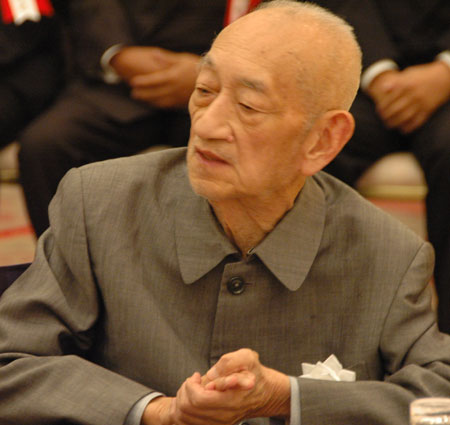
May 27, 2007; Volume 8, #40
World
Go News from the American Go
Association
May
27, 2007; Volume 8, #40
SPECIAL
WORLD AMATEUR GO CHAMPIONSHIP EDITION:
LIVING LEGEND GO SEIGEN
HELPS LAUNCH WAGC
THE TRAVELING BOARD: Tokyo’s
Diamond; Living and Dying at
Ueno Station
Chris Garlock, the E-Journal’s Managing Editor, and AGA
Communications Vice-President, is attending the World Amateur Go
Championships (WAGC) in Tokyo this week as a Guest Official for the
American Go Association. Look for his reports -- and more photos -- on
the WAGC
on the website and in the E-Journal over the next week. All photos
(except as noted) by EJ photographer John Pinkerton.
LIVING
LEGEND GO SEIGEN HELPS LAUNCH WAGC: The legendary Go
Seigen (above)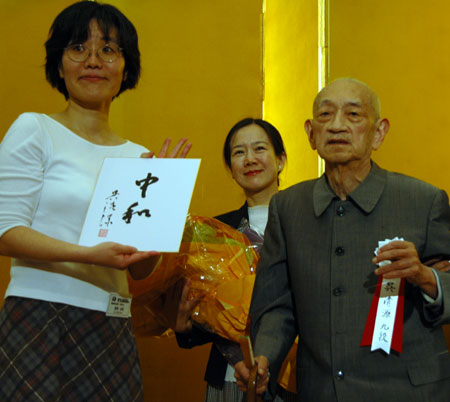 was the surprise highlight of
the opening ceremonies at the 28th World Amateur Go Championships
(WAGC) on Sunday. The 92-year-old go master arrived at the evening
kick-off in a wheelchair but was able to take the stage to accept a
huge bouquet of flowers, wish the assembled players good luck and to
present International Go Federation Secretary General Yuki Shigeno with
his calligraphy (left). Afterwards, Go held court with his wife and
Nihon Kiin officials as awed players from around the world approached
to thank him, shake his hand and pose for pictures. Modern master
Takemiya Masaki – his smile as quick and broad as ever
– happily joined in, cheerfully posing for photos and
chatting easily with Go Seigen’s well-wishers.
was the surprise highlight of
the opening ceremonies at the 28th World Amateur Go Championships
(WAGC) on Sunday. The 92-year-old go master arrived at the evening
kick-off in a wheelchair but was able to take the stage to accept a
huge bouquet of flowers, wish the assembled players good luck and to
present International Go Federation Secretary General Yuki Shigeno with
his calligraphy (left). Afterwards, Go held court with his wife and
Nihon Kiin officials as awed players from around the world approached
to thank him, shake his hand and pose for pictures. Modern master
Takemiya Masaki – his smile as quick and broad as ever
– happily joined in, cheerfully posing for photos and
chatting easily with Go Seigen’s well-wishers.
New Nihon Kiin President Hiromu Okabe
officially welcomed the players from 68 countries and territories,
noting that “there are now an estimated 40 million go players
in 70 countries.” Okabe said that the WAGC was founded to
promote go and international friendship and reminded the players that
“Go is a form of communica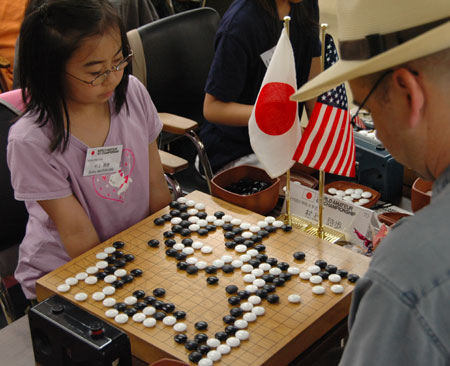 tion and
we hope you use this opportunity to make lots of friends.”
Okabe also thanked the WAGC’s sponsors for their support,
including the Chiyoda Association for Culture and Arts,
Toyota/Denso, Japan Airlines and Autodesk.
tion and
we hope you use this opportunity to make lots of friends.”
Okabe also thanked the WAGC’s sponsors for their support,
including the Chiyoda Association for Culture and Arts,
Toyota/Denso, Japan Airlines and Autodesk.
As the assembled players enjoyed a
sumptuous buffet, the first-round pairings were announced: US
player Andy Liu 8d will play Bei Gei 5d of the UK on Monday
morning.
The WAGC got off to a convivial start earlier Sunday afternoon with the
traditional Friendship Match at the Nihon Kiin. The WAGC players were
joined by guest officials and a group of young go players for a fun
round before the main event begins Monday morning. Nine-year-old Shiho
Murakami 10k (above right) – who has been playing just six 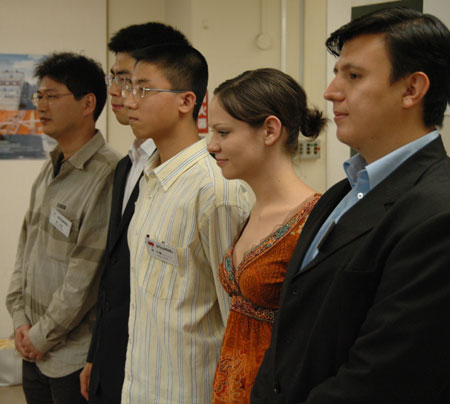 months
– defeated E-Journal Editor Chris Garlock by 1 point in their
game, which was counted by Yukari Umezawa (of Hikaru no Go fame),
one of the go celebrities in attendance.
months
– defeated E-Journal Editor Chris Garlock by 1 point in their
game, which was counted by Yukari Umezawa (of Hikaru no Go fame),
one of the go celebrities in attendance.
At a press conference later Sunday
afternoon, top contenders fielded questions from
reporters, including Garlock, who got to ask the lead-off question
about the state of world go. Hironobu Mori 7d of Japan confessed that
“Until recently, I thought Western go was pretty weak, but I
was playing on the internet the other day and saw some great play by
western players so I have to change my mind.”
Thirteen-year-old Zi Teng Shan 8d is carrying China’s hopes
for a WAGC title, while Korea’s Dong-Ha Woo 7d said simply
“I’m here to win all my games.” Rita
Pocsai 4d of Hungary – 18 years old and the
tournament’s only female player – is following in
the footsteps of her father, Tibor Pocsai, who has placed as high as
9th in the WAGC. Luis Cajiao 2d of Costa Rica got turned onto go by
Hikaru No Go and then learned to play on the internet. Photo
(from left): Hironobu Mori, Dong-ha Woo, Zi Teng Shan, Rita Pocsai
& Luis Caliao.
THE
TRAVELING BOARD: Tokyo’s Diamond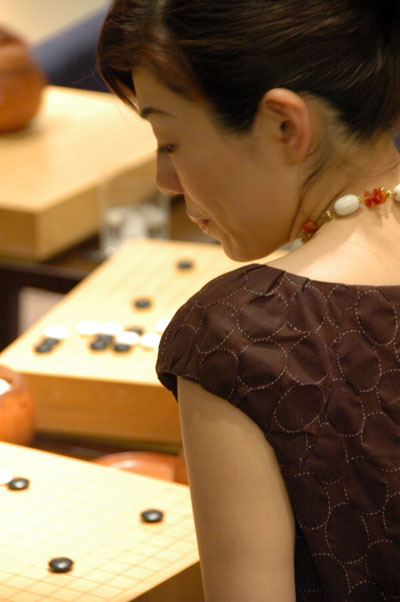
By Chris Garlock
The streets of nighttime Tokyo glistened
in the rain. A few inebriated salarymen lurched past carefully,
oblivious to the cool drizzle. Neon gleamed wetly. “Not much
farther,” promised Jeremy, “it should be just
around the next corner.”
Just a few hours after landing at Narita
Airport, E-Journal photographer John Pinkerton and I were headed for
our first go club. In Tokyo to cover the World Amateur Go Championships
(WAGC), we’d been delivered to our hotel with prompt
efficiency Friday night by the Nihon Kiin’s Hideko Okada, who
informed us that we were free to explore the sights of Tokyo until the
WAGC opening ceremonies Sunday afternoon at the Nihon Kiin.
For a couple of go players –
even an exhausted and somewhat bedraggled pair like John and me
– that did not mean shopping in Ginza, taking in a kabuki
show or any of the hundreds of other possibilities that beckoned from
the bustling city. We’d come to Japan for go and we knew it
was out there somewhere. Unfortunately, our glossy guidebooks were
useless in this quest and while my pre-trip research had yielded a few
club names, addresses were hard to come 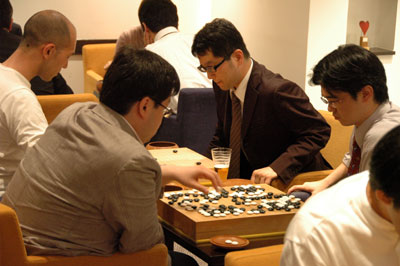 by and
nearly impossible to locate, language-challenged as John and I are. The
friendly concierge at the Grand Arc Hanzomon had helpfully explained
– after a surprised look at our query – that there
were no go clubs in the area, but a quick phone call later, Jeremy
Banzhaf had charmed out of her not only the name of a nearby salon in
Chiyoda-ku, but directions and a map. Banzhaf, a
twenty-something fellow Empty Sky Go Club member, has been living and
working in Tokyo for the last four years and generously dropped
everything – including his date – to be our guide
for the evening.
by and
nearly impossible to locate, language-challenged as John and I are. The
friendly concierge at the Grand Arc Hanzomon had helpfully explained
– after a surprised look at our query – that there
were no go clubs in the area, but a quick phone call later, Jeremy
Banzhaf had charmed out of her not only the name of a nearby salon in
Chiyoda-ku, but directions and a map. Banzhaf, a
twenty-something fellow Empty Sky Go Club member, has been living and
working in Tokyo for the last four years and generously dropped
everything – including his date – to be our guide
for the evening.
Around the corner, the emerald green
sign emblazoned with a highly stylized go stone beckoned. Down a short
corridor, up three floors and there was go heaven, through the glass
door. We hesitated a moment. Jeremy had been here before, but as a
guest of a member of this salon, and he knew admittance was neither
guaranteed nor cheap. The smokiness was a given. Still, we were
well-armed with a copy of this year’s American Go Yearbook,
business cards identifying ourselves as go journalists, my trusty
report’s notebook and John’s longlensed Nikon
dangling prominently from his shoulder.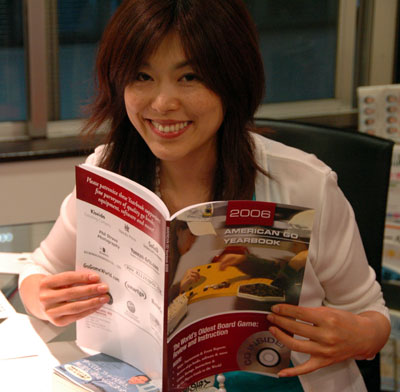
In the end, of course, being go players
was all that mattered. Salon owner/manager Yoshiko Inaba – a
strikingly beautiful former Nihon Kiin insei (in photo at right) --
welcomed us with a radiant smile, inviting us to look around, take
photos and generously consenting to an impromptu interview, with Jeremy
valiantly translating. The salon, open just five years, is a new breed
of go club quite different from the old smoky lairs of retired
businessmen. Smoking, for one, thing, is restricted to the small bar
area, resulting in a near smoke-free environment that Ms. Inaba says is
much more welcoming to the younger crowd that patronizes her salon.
Membership fees at the Diamond run into
the hundreds of dollars, between the application and annual fees, but
this entitles the club’s 350 members to free attendance, as
well as access to an impressive stable of teachers, all current or
former insei and many quite well known. Ms. Inaba, who I later found
out will serve as the MC at Sunday’s WAGC opening ceremony,
is an announcer on an NHK go program and a colleague and good friend of
Michael Redmond 9P. Yoshito Hori, a famous player and author, has
helped organize the series of events and outreach that has brought more
young people – including women – to the salon, said
Ms. Inaba, who also mentioned that Yukari Umezawa 5P –
renowned as “the most beautiful Japanese woman ever to become
a professional go player” – is also involved with
the Diamond.
Late on a rainy Friday night, the Diamond
Salon’s twenty 2-inch table boards were almost all filled with
young businessmen -- many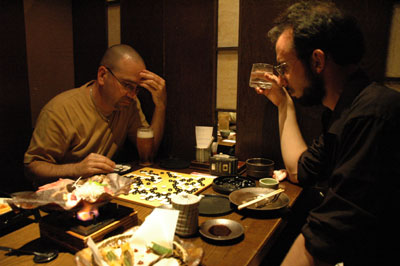 still in
their coats and ties – as well as a half-dozen women. Ranging
in strength from double-digit kyu to the 7 dan who was cheerfully
playing two female club members, the players were all serious, intent
on the game that has entranced this country for thousands of years.
Asked her advice on how to get stronger, Ms. Inaba smiled and
thought carefully before replying. “Don’t grind
away,” she said. “Enjoy the game and play in an
exciting and fun atmosphere. That way you’ll naturally get
stronger.”
still in
their coats and ties – as well as a half-dozen women. Ranging
in strength from double-digit kyu to the 7 dan who was cheerfully
playing two female club members, the players were all serious, intent
on the game that has entranced this country for thousands of years.
Asked her advice on how to get stronger, Ms. Inaba smiled and
thought carefully before replying. “Don’t grind
away,” she said. “Enjoy the game and play in an
exciting and fun atmosphere. That way you’ll naturally get
stronger.”
Good advice that we promptly availed
ourselves of, as Jeremy took us to a favorite restaurant where
– tucked away in a private booth where our portable go board
didn’t merit so much as a second glance (l) -- he introduced
us to the pleasures of deepfried chicken cartilage, raw horse and other
Japanese delicacies, washed down with good Japanese beer and kokutou, a
smooth and smoky shochu brewed from black sugar (though it can also be
brewed from almost anything, including sweet potatoes and seaweed).
Maybe it was just being in Tokyo, the
home of so much go – Ms. Inaba told us that there are
hundreds of go clubs in the city – or perhaps it was the
lingering effects of having visited the classy Diamond Go Salon, but
both games at the restaurant – despite plenty of beer and
shochu – were two-pointers. When we finally dragged ourselves
away from the board after the 4 a.m. last
call, dawn was breaking over Tokyo, the clouds had lifted and the empty
streets echoed with the haunting cries of the jet-black crows who
perched on the streetlamps above us as we headed home for a few hours
sleep.
Check out the Diamond Go Salon online (in Japanese) or call 03-3263-0620
THE
TRAVELING BOARD: Living and Dying at Ueno Station
My groups keep dying. Whoever wrote that
large dragons don’t die hasn’t been watching my
last half-dozen games. Each group has been bigger than the last,
twisting and turning vainly across the board in a desperate search for
life. All my attacks fizzle out ingloriously and every tesuji, each one
more clever than the last, is refuted by ever more elegant
counter-tesujis. I am being beaten as thoroughly as I ever have in
twenty years of playing go, and I can’t stop smiling.
The Ueno Go Center is a classic Tokyo go
club, filled with old men with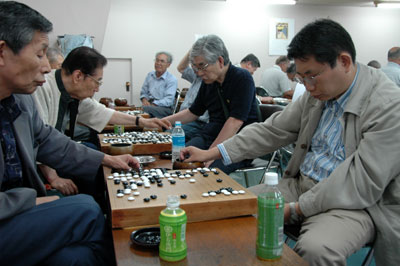 nicotine-stained fingers playing in a smoky haze. Light floods
through the club’s front wall of windows on the third floor
of the Shouchiku Department Store, overlooking the Ueno
Station’s Yamanote and Keisei train lines and the steady
rumble of the passing trains merges with the click of stones to mark
the passing time as day slips away into night.
nicotine-stained fingers playing in a smoky haze. Light floods
through the club’s front wall of windows on the third floor
of the Shouchiku Department Store, overlooking the Ueno
Station’s Yamanote and Keisei train lines and the steady
rumble of the passing trains merges with the click of stones to mark
the passing time as day slips away into night.
There are over 100 boards here and
during the course of a long Saturday afternoon and evening, as sumo
played silently on a small television in t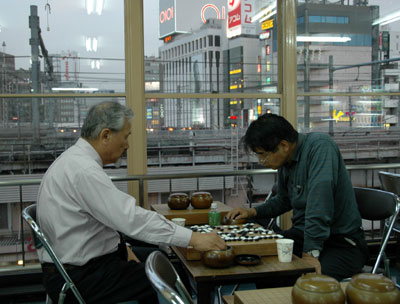 he
background, dozens of them were full at any given point, shifting
across the large room like a
timelapse movie as players came and went,
their faces changing but the tableau of men,
boards and stones remaining the same, an ancient scene caught in smoky
amber.
he
background, dozens of them were full at any given point, shifting
across the large room like a
timelapse movie as players came and went,
their faces changing but the tableau of men,
boards and stones remaining the same, an ancient scene caught in smoky
amber.
E-Journal photographer John Pinkerton
and I are accompanied by our guide and translator Jeremy
Banzhaf and old friend Kazunari Furuyama. Known to his many go friends
as “Kaz,” the former insei and local go teacher
authored a popular column for the E-Journal that he’s now
ready to resume. “The problem,” Kaz says worriedly,
“is that I have a lot of brand new material and a lot of old
material too, and I don’t know what’s best to
use.” John, Jeremy and I look at each other and
simultaneously tell him “No problem; use both!” Kaz smiles
in relief and so do we.
It costs just $8 a day to play at the
Ueno Go Center. Little or no English is spoken here, but the manager
lady assures us that all a non-Japanese visitor needs to do is
“hold up as many fingers as your ranking and we’ll
take care of you” and indeed, within minutes of arriving,
both John and I are on the boards. My first oppon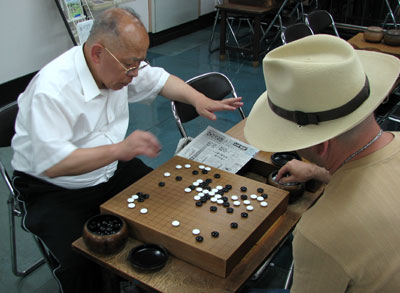 ent is a
wizened old man right out of a Japanese print, with longish white hair,
a wispy beard and the some of the fastest fingers I’ve ever
seen. Mr Senza tells us proudly he’s 80 years old and has
been playing go for more than thirty years. I’m embarrassed
to admit that I showed no respect for my elder, winning the game by
over twenty points.
ent is a
wizened old man right out of a Japanese print, with longish white hair,
a wispy beard and the some of the fastest fingers I’ve ever
seen. Mr Senza tells us proudly he’s 80 years old and has
been playing go for more than thirty years. I’m embarrassed
to admit that I showed no respect for my elder, winning the game by
over twenty points.
My comeuppance arrives shortly in the
form of my next opponent, Yasuo Shimizu 7d who’s anxious to
play me. He’s silent as the grave as the stones go down,
light reflecting off his inscrutably bald head. I get off to a rocky
start when I misplay a joseki – badly, as Kaz shows me later
– but my opponent doesn’t take full 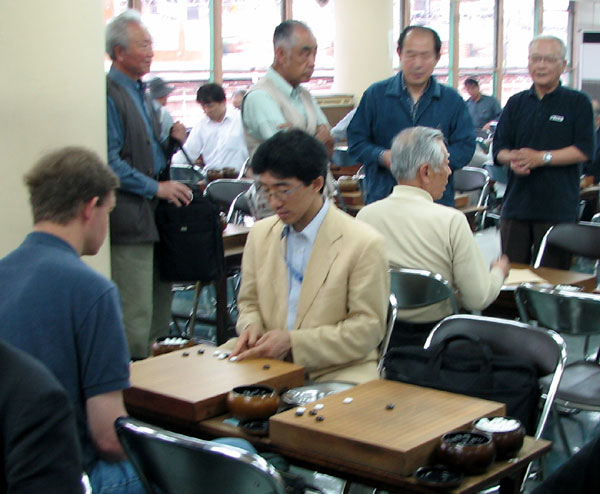 advantage
and I recover with a nice double-attack. Things seem to be going
alright until Shimizu begins gently jabbing at my poor
group’s vital points, and things go downhill pretty quickly
from there. As we clear the stones from the board, he asks me if
I’ve studied with “Redmond-san” and
I’m very relieved to be able to assure him that American-born
Michael Redmond 9P is not my teacher and thus not responsible for my
weakness.
advantage
and I recover with a nice double-attack. Things seem to be going
alright until Shimizu begins gently jabbing at my poor
group’s vital points, and things go downhill pretty quickly
from there. As we clear the stones from the board, he asks me if
I’ve studied with “Redmond-san” and
I’m very relieved to be able to assure him that American-born
Michael Redmond 9P is not my teacher and thus not responsible for my
weakness.
As Shimizu
and I continue playing, Kaz has launched into an
impromptu lesson with John a few tables over (photo at left by Jeremy
Banzhaf), digging deeper and deeper into variations and illustrations
of fundamentals of play. John, as always the avid student, starts
taking photos of the variations at one point, which reminds me to make
sure we’ve gotten all the club photos and information we
need. Hours pass and eventually, my groups all live. My opponent looks
disappointed. I resign, nearly twenty points down.
The Ueno Go Center is literally a
stone’s throw from Ueno Station; the address is Tokyo-to,
Taito-ku, Ueno Koen 1-54; phone 03-3831-3137. Look for the big
Shouchiku Department Store sign; you’ll be able to see go
players in the third-floor windows of the club. There’s a
non-smoking section but the cigarette smoke goes where it wants; the
ventilation system keeps things tolerable, though. There are several of
the ubiquitous drink vending machines in the club, including an
“Espresso Bar” machine where you can also get
“creamy tea” and of course plenty of the green tea
you’ll need to keep sharp during long hours on the go board.
Don’t miss the famous Ichiran noodle shop across the street,
where the affordable and delicious ramen is among the best in Japan,
according to Jeremy, who came to Japan as much for the food as for the
go.
- Chris Garlock
Published by the American Go Association
Managing Editor: Chris Garlock
Assistant Editor: Bill Cobb
Text material published in the AMERICAN GO E JOURNAL may be reproduced
by any recipient: please credit the AGEJ as the source. PLEASE NOTE that
commented game record files MAY NOT BE published, re-distributed, or
made available on the web without the explicit written permission of the
Editor of the E-Journal. Please direct inquiries to journal@usgo.org
Articles appearing in the E-Journal represent the opinions of the
authors and do not necessarily reflect the official views of the
American Go Association.